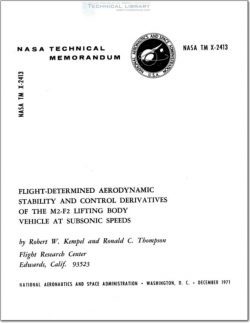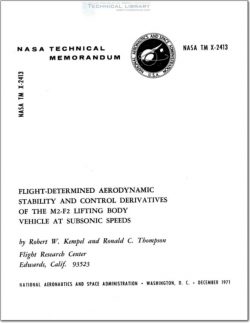NASA-TM-X-2413

- Version
- 175 Downloads
- 1.57 MB File Size
- 1 File Count
- June 15, 2016 Create Date
- June 15, 2016 Last Updated
Flight Determined Aerodynamic Stability and Control Derivatives of the M2-F2 Lifting Body Vehicles at Subsonic Speeds

The longitudinal and lateral—directional stability and control derivatives determined
from flight tests of the M2—F2 lifting body research vehicle are presented for a range
of Mach numbers from 0. 41 to 0.64 and for angles of attack from -2. 3° to 13. 8°. The
derivatives were determined by using a high—speed repetitive analog—matching technique
and approximate equations to analyze recorded 'time histories of vehicle response to
random control inputs and pulses. The flight-determined derivatives were compared
with wind-tunnel predictions for representative Mach number and angle—of—attack con—
ditions. Using these derivatives, the vehicle modal-response characteristics were
calculated.
Comparisons of flight and wind-tunnel results indicated that the flight—determined
longitudinal aerodynamic static stability, lower—flap effectiveness, and pitch damp—
ing were generally higher than predicted. The normal—force—curve slope as well as
the lateral—directional aerodynamic stability and control effectiveness generally agreed
with wind—tunnel predictions. In general, the lateral-directional—damping derivatives
were in good agreement with predictions.
The first manned flight tests of lifting body reentry vehicle configurations were
made at the NASA Flight Research Center, Edwards, Calif. , under the joint sponsor—
ship of NASA and the U. S. Air Force. The test program was designed to investigate
performance, stability and control, and flying—quality requirements of this new class
of vehicle throughout the subsonic, transonic, and low supersonic flight regions. Test—
ing was started with the lightweight M2—F1 vehicle; the results of these tests are re—
ported in reference 1. Subsequently, to expand the limited performance envelope of
the basic M2—F1, a heavier and more sophisticated vehicle, the M2—F2, was designed
and built. The M2—F2 was designed for launch from a B—52 carrier aircraft and was
capable of either a glide flight to landing or an accelerated flight to higher altitudes and
speeds utilizing a modified LR—ll rocket engine, followed by a glide flight to landing.
The first glide flight of the M2-F2 was made on July 12, 1966; in the following 8 months,
16 glide flights were completed. On the last flight, before the powered phase of the
program, the vehicle was damaged extensively in a gear—up landing.
| File | Action |
|---|---|
| NASA-TM-X-2413 Flight Determined Aerodynamic Stability and Control Derivatives of the M2-F2 Lifting Body Vehicles at Subsonic Speeds.pdf | Download |
Comment On This Post